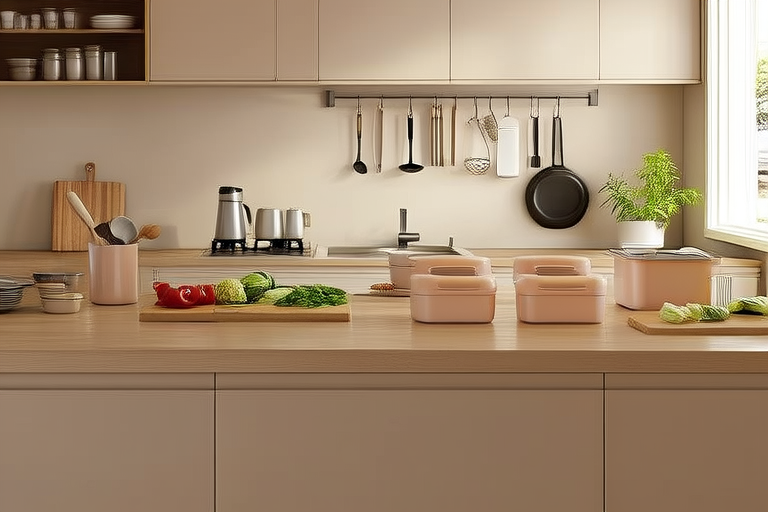Streamline Your Daily Prep: Effective Strategies for Kitchen Organization Success
Introduction
In today’s fast-paced world, having an organized kitchen can make all the difference in your daily routine. A well-organized kitchen not only saves time but also reduces stress and enhances productivity. Whether you’re a seasoned chef or a beginner cook, streamlining your kitchen prep is essential for efficiency and creativity. This article will guide you through effective strategies to achieve kitchen organization success, helping you create a space that is both functional and inviting.
Understanding the Importance of Kitchen Organization
Before diving into specific strategies, it’s crucial to understand why kitchen organization matters. An organized kitchen allows you to find what you need quickly, reducing the likelihood of wasted ingredients or forgotten meals. It also promotes safety by minimizing clutter and ensuring that sharp tools and hazardous materials are stored properly. Additionally, a tidy kitchen can inspire creativity, making meal preparation more enjoyable.
The Role of Storage Solutions
One of the key aspects of kitchen organization is efficient storage. Proper storage solutions can transform your kitchen from chaotic to calm. Start by assessing the space you have available and identifying areas where you can maximize storage without sacrificing functionality. Consider using vertical space with shelves, hooks, and pegboards to keep frequently used items within reach while freeing up counter space.
Utilizing Drawer Dividers and Bins
Drawer dividers and bins are excellent tools for keeping small items like utensils, spices, and condiments neatly organized. By categorizing these items, you can easily locate what you need without rummaging through drawers. Opt for clear containers or labels to ensure everything remains visible and accessible. This method not only keeps your drawers tidy but also helps in maintaining a clutter-free countertop.
Investing in Quality Shelving Units
Quality shelving units can significantly enhance your kitchen’s organizational capabilities. Look for adjustable shelves that allow you to customize the height based on the size of your items. Consider installing pull-out shelves under cabinets to optimize space and prevent bending over. These additions make it easier to access less frequently used items while keeping the most commonly used ones within easy reach.
Implementing Smart Cooking Techniques
Beyond physical organization, adopting smart cooking techniques can further streamline your daily prep. Meal planning and batch cooking are two powerful methods that can save time and reduce food waste.
Meal Planning and Batch Cooking
Meal planning involves setting aside time each week to plan your meals for the upcoming days. By doing so, you can shop more efficiently, avoid last-minute decisions, and ensure that you have all necessary ingredients on hand. Batch cooking takes this a step further by preparing multiple servings at once, which can be frozen or refrigerated for future use. This approach is particularly beneficial for busy individuals who want to maintain a healthy diet without spending excessive time in the kitchen.
Creating a Shopping List
A well-thought-out shopping list is essential for successful meal planning. Before heading to the grocery store, review your planned meals and compile a comprehensive list of required ingredients. Stick to this list to avoid impulse buys and unnecessary purchases. Organizing your list by category (e.g., produce, dairy, pantry) can also speed up the shopping process and help you stay focused.
Efficient Use of Space and Appliances
Maximizing the use of your kitchen appliances and tools can also contribute to a more organized workflow. Ensure that your appliances are strategically placed for optimal accessibility. For example, place your microwave near the sink if you often reheat leftovers after washing dishes. Similarly, position your coffee maker in a spot that allows for quick access in the morning.
Leveraging Technology
Technology can play a significant role in enhancing kitchen organization. Consider investing in smart appliances that offer features such as voice control, preset cooking settings, and automated cleaning. Apps that track inventory and suggest recipes based on available ingredients can also be invaluable tools for managing your kitchen efficiently.
Practical Tips and Case Studies
To bring these strategies to life, let’s look at some practical tips and real-world examples.
Case Study: Sarah’s Kitchen Makeover
Sarah, a busy working professional, found herself constantly frustrated by her disorganized kitchen. After implementing several of the strategies mentioned above, she noticed a significant improvement in her daily prep routine. She started by decluttering her countertops and installing drawer dividers and bins. She also began meal planning and batch cooking, which reduced her weekly grocery trips and minimized food waste. Sarah now enjoys a more relaxed and efficient cooking experience, thanks to her newly organized kitchen.
Step-by-Step Guide to Organizing Your Pantry
- Empty and Sort: Begin by removing all items from your pantry and sorting them into categories (e.g., canned goods, grains, snacks).
- Inspect and Discard: Check expiration dates and discard any expired or unused items.
- Organize: Place items back in the pantry using clear bins or labels for easy identification. Arrange items by frequency of use, placing frequently accessed items at eye level.
- Maintain: Regularly review and restock your pantry to ensure it remains organized and functional.
Conclusion
Achieving kitchen organization success requires a combination of thoughtful planning, strategic storage solutions, and smart cooking techniques. By implementing the strategies outlined in this article, you can create a more efficient and enjoyable kitchen environment. Remember, the key is consistency—regular maintenance and adjustments will help sustain an organized space over time. Start small, and gradually incorporate more advanced techniques as needed. With these efforts, you’ll soon find that your kitchen prep becomes smoother and more rewarding.
